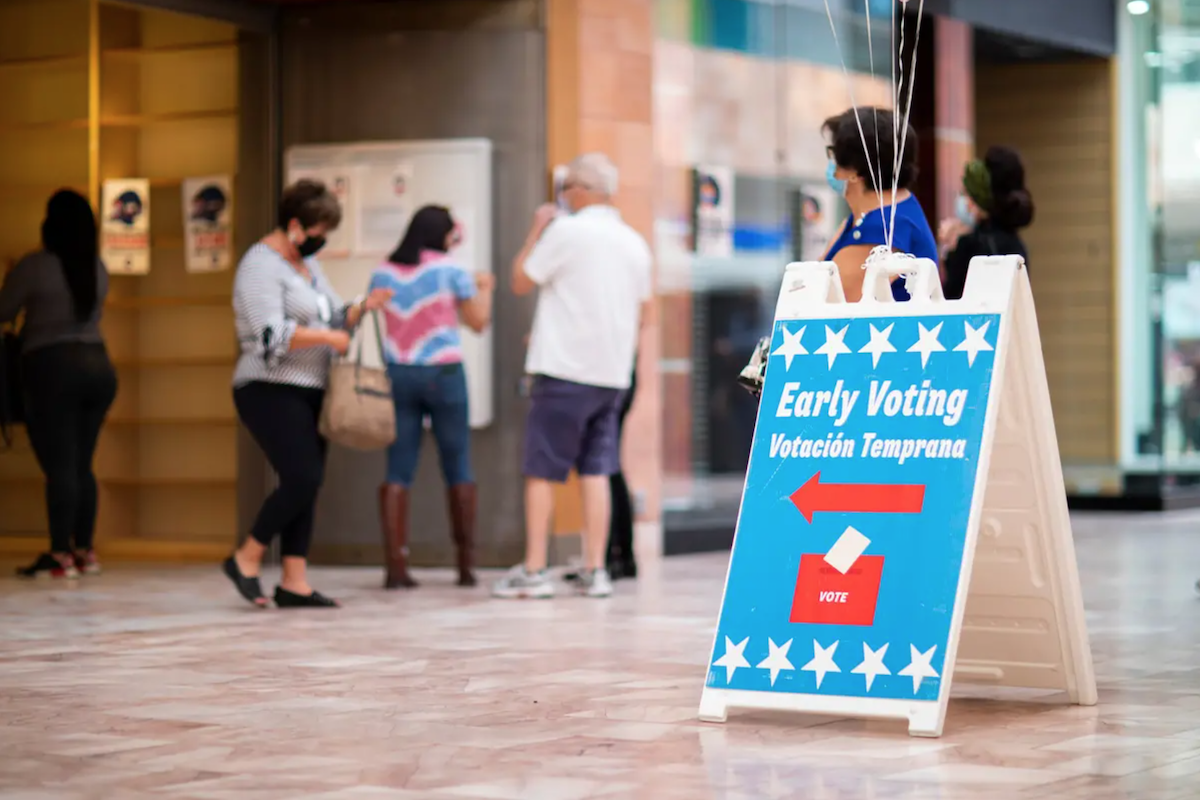

Early voting began in Texas on October 13 (Ivan Pierre Aguirre for The Texas Tribune)
The Texas Tribune is a nonprofit, nonpartisan media organization that informs Texans —and engages with them— about public policy, politics, government and statewide issues. This story was originally published on The Texas Tribune here.
By Kelsey Carolan
When Jill Biden toured Texas this month in support of her husband’s presidential bid, her first stop was in El Paso, a more than 80% Hispanic city. She spoke there in front of a sign that read, “Vota Ahora,” or Vote Now.
“For the first time in a long time, winning Texas is possible,” she said.
The setting seemed to be a nod to a political reality that most Democrats in the state acknowledge: If they are going to turn Texas blue this year, they need the help of Latino voters.
This election, Latinos will be the nation’s largest racial or ethnic minority voting bloc with 32 million projected to be able to vote—13.3% of all eligible voters, according to the Pew Research Center. In Texas, they make up 30% of eligible voters. Projections indicate Hispanics could become the largest population group in Texas as soon as 2022.
Democrats have long cited the state’s shifting demographics as evidence that its future is blue. But attempts to take full advantage have so far fallen short. Latino voter turnout has traditionally been low in the state. The party has often seen President Donald Trump’s rhetoric about immigration and people of color as an opening to win over and motivate more Latino voters to come support their candidates at the polls. But dating back to the March presidential primary in Texas, Biden has struggled to make gains with those voters. And Republicans in the state have long argued that the state’s Latino population is less liberal than many Democrats believe.
A Dallas Morning News poll found in August that Biden was leading against President Trump among registered Latino voters in Texas by about 9.5 percentage points—a margin much narrower than the 27-point margin Hillary Clinton had with those voters in Texas in 2016, according to exit polls. In October, a University of Texas/Texas Tribune poll showed Biden with a 17-point lead among Latino voters in Texas.
Biden lost the Latino vote to Bernie Sanders in the 2020 Democratic primary.
As Bernie Sanders wins the #SuperTuesday Colorado primary, @julito77 says he thinks he will also do well in Texas tonight. "It has a lot to do with young Latinos." https://t.co/VcrcZLNEvh pic.twitter.com/06DT5BhoAk
— Democracy Now! (@democracynow) March 4, 2020
Still, many in the party see hope for this November. Despite a pandemic that has disproportionately affected Hispanic and Latino communities in Texas, a University of Houston and Univision poll found that 90% of Texas Latino voters will or will probably vote in the 2020 presidential election. And 79% responded that it is more important to vote in this election than it was to vote in the 2016 presidential election.
The outreach is coming from all areas: Democratic candidates up and down the ballot, groups devoted specifically to reaching Latino voters and even the party itself. Abhi Rahman, communications director for Texas Democrats, said the state party has registered 1.5 million voters in Texas since 2016. He said of those new voters, many are young Latinos. A national Telemundo-Buzzfeed News survey of Latino voters found that 60% of Latino voters between the ages of 18 and 34 planned to vote for Biden.
Jolt Action, a voter advocacy group, has been trying to increase voter turnout among young Latino voters in Texas. According to a study it co-conducted, an annual average of nearly 210,000 Latinos already living in Texas will turn the eligible voting age of 18 each year from 2018 to 2028. Antonio Arellano, interim director for the group, said the 214,000 votes Democrat Beto O’Rourke needed to unseat U.S. Sen. Ted Cruz in 2018 can now be found in the young Latino constituency.
“The Latino electorate is young so if you win them over, you don’t just win them just for one election cycle, you win them for generations to come,” Arellano said.
Jason Villalba, a former Republican member of the Texas House of Representatives and president of the Texas Hispanic Policy Foundation, said if Biden is able to replicate O’Rourke’s success in turning out young Latino voters, he may have a chance of flipping the state. He said that much of the relative weakness Biden has shown with regard to Latino voters in Texas can be blamed on outreach and lack of name recognition in Texas compared with Clinton in 2016.
And he said Sanders won the demographic in the March primary because he employed much of the same engagement and infrastructure of O’Rourke’s 2018 Senate campaign with young Latino voters.
Right before Super Tuesday, a Center for Information & Research on Civic Learning and Engagement poll found that 70% of Texas Latino voters between the ages of 18 and 29 said they had not been contacted by a campaign during the 2020 primaries.
“Historically, the fact that Latinos haven’t voted is not their fault,” Arellano said. “It’s that nobody has cared enough in activating them and speaking directly to them and mobilizing them.”
Organizations like Jolt and MOVE Texas, a nonpartisan nonprofit that aims to empower underrepresented young people in Texas to engage in politics and advocacy, are trying to make up for what many campaigns haven’t done in the past, like knocking on doors in underrepresented communities and mailing voter registration forms to young Black and brown voters.


